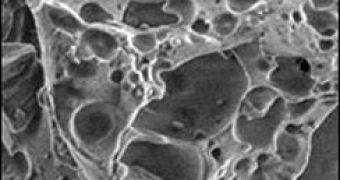A new research points out the fact that the smallest particles in lunar dust might be toxic, and could be a possible threat to astronauts inhaling them.
These health effects have been signaled since NASA's Apollo missions. Astronaut Harrison H (Jack) Schmitt, the last man to step on to the Moon in Apollo 17, complained of "lunar dust hay fever".
NASA wants now to assess the effects of prolonged exposure and to fix the issue before humans return to the Moon in 2020. A team at the University of Tennessee (UT) in Knoxville is also looking for ways of using magnets to filter dust from the living environments of lunar bases and spacecraft. "I've been working on lunar samples for 35 years and I have looked at fractions down to a few microns (millionths of a metre), but never anything less," said Professor Larry Taylor, director of the Planetary Geosciences Institute at Tennessee.
"The medical doctors are interested in things that are less than about three microns. So we did some particle size determinations and discovered that a very large portion of lunar soil is potentially dangerous, approximately 1-3% of the total soil by weight."
The respiratory tract, by coughing or through specialized hairs named cilli, removes any particle larger than 2.5 microns, but the smaller will stick in lung walls, causing inflammation. A scar tissue (fibroid) wraps the particle, replacing lung's cells involved in the oxygen-carbon dioxide (CO2) exchange.
This occurs in silicosis, induced by mining, quarrying or foundry work, asbestosis, a result of asbestos fibers inhalation, bronchitis or smoking. "If you took a healthy pair of adult lungs and smeared them out, they would cover a football field. Once you are down to the size of a square table's worth of surface area in your lungs that is usable; you are just about dead", said Taylor.
The UT team found that about 1 % by weight of lunar dust contains particles less than one micron in size. Most of the fine particles were made of glass resulted from the impact of micrometeorites on the Moon, but also iron grains of just 10-20 nanometers in size. These grains are so small that, if inhaled, some could pass directly from the lungs into the blood stream, impairing the oxygen transporting hemoglobin in a similar effect to carbon monoxide poisoning.
Some fine dust particles were found to be filled with holes. "These vesicles give them a much larger surface area to react with the lung tissue," said Dr Yang Liu, a postdoctoral research associate at the University of Tennessee. "If you have a solid particle of dust and add vesicles, you can calculate how much the reactive surface area is increased. Sometimes you can get increases of up to a factor of five," she added.
"With jagged particles, because of the way they follow the path of the air, there's a lower chance of them impacting the sinus walls at the back of the throat - which is the body's defense mechanism for keeping particles out of the lungs," said Dr Benjamin Eimer from the UT.
The nano-phase iron could be greatly removed with a simple hand-held magnet which attracts all particles smaller than 50 microns. "I discovered that if you put lunar soil in your microwave oven, next to your tea, it will melt at 1,200C before your tea boils - which is a magical thing," said Taylor.
Taylor has designed a wheeled vehicle that could fire microwaves at the lunar soil and has developed a prototype microwave device for the Moon. This action would impede dust being kicked up by the manned spacecraft and vehicles. "If they are going to do any work on the Moon, they don't want dust in the way, so there is a big effort to minimize it," said Eimer.
The Lunar Air Filter with a Permanent Magnet System (LAF-PMS) is made of more magnets placed with their magnetic poles very close, making a large field gradient that attracts moon dust particles from the air. When the filter turned off, the dust can be cleaned.
The Lunar Soil Magnetic Collector (LSMAC) is made of wound magnetic coils located along a tube that could be turned on in sequence to effectively "suck up" lunar dust, like a leaf-gathering machine. "We will want to collect the soil to extract oxygen and hydrogen and perhaps to use for building materials. So we will have to collect massive amounts of lunar regolith. Our idea was to make something that could gather up the soil without creating a large dust cloud", Dr Eimer said.

 14 DAY TRIAL //
14 DAY TRIAL //